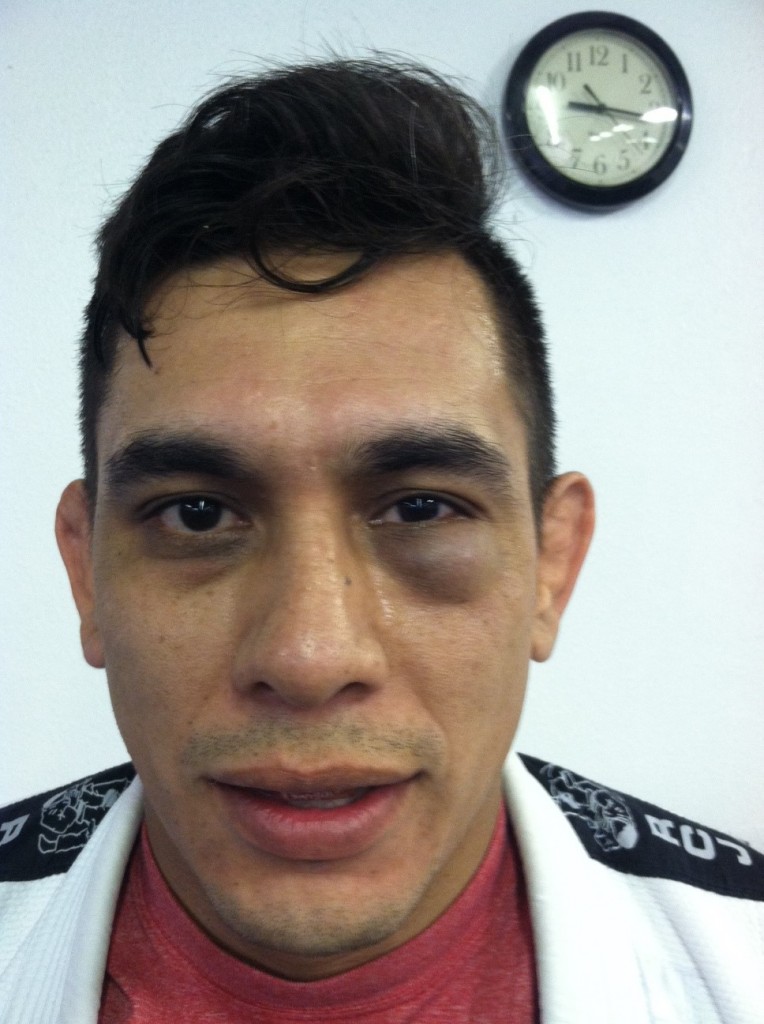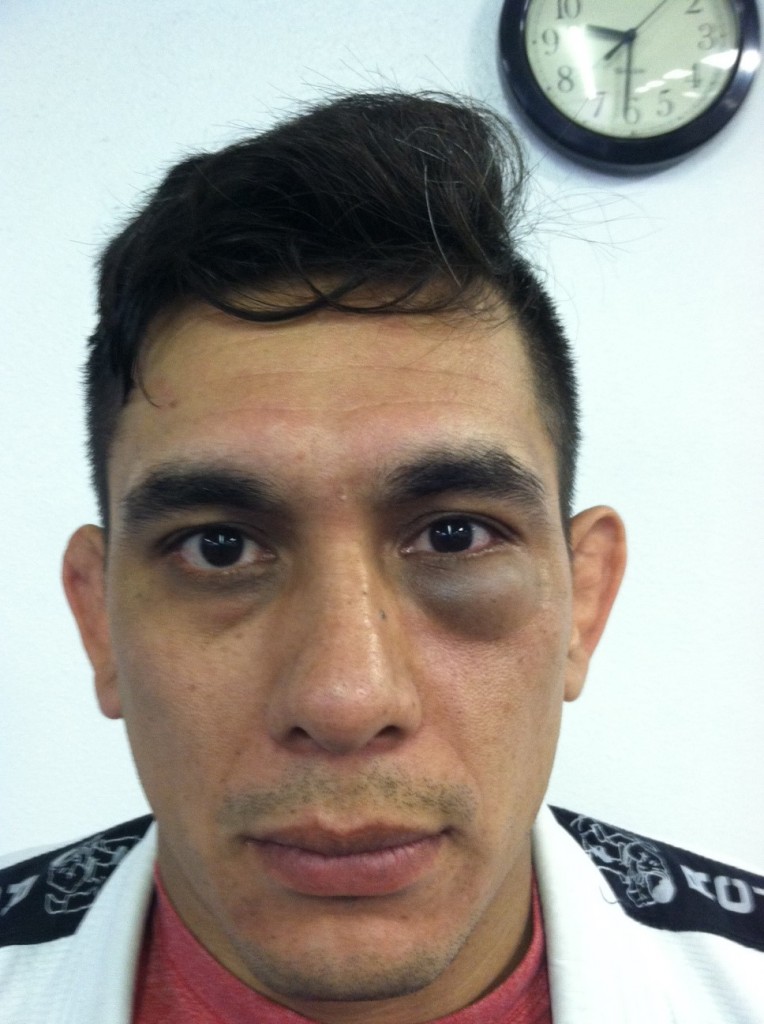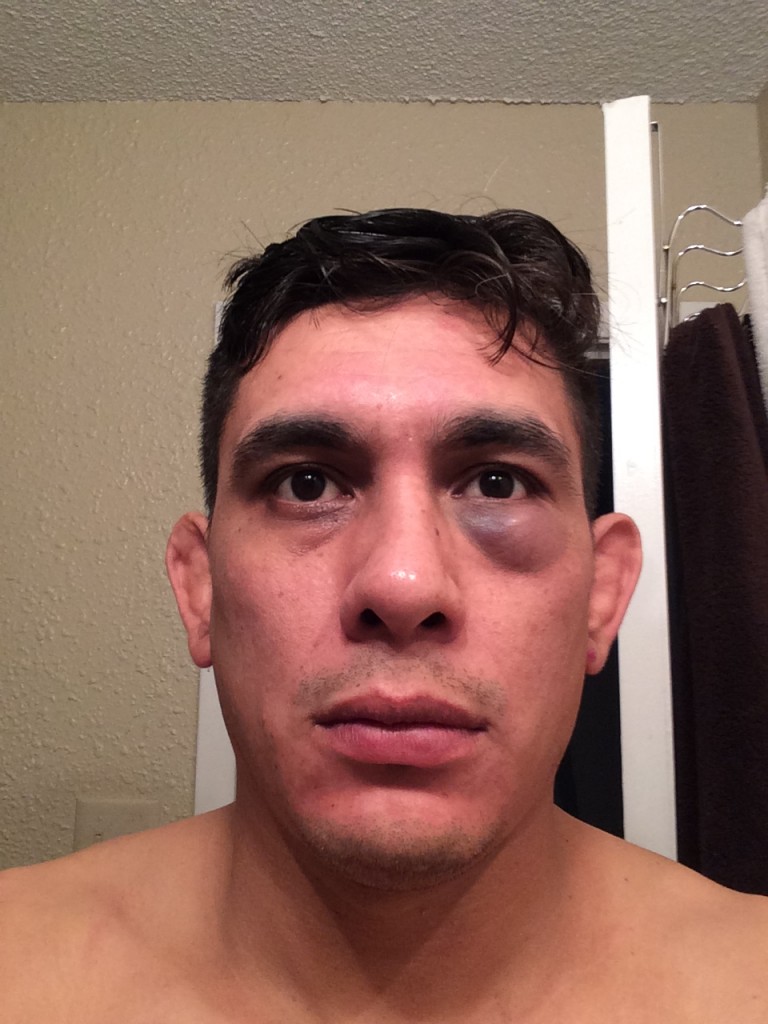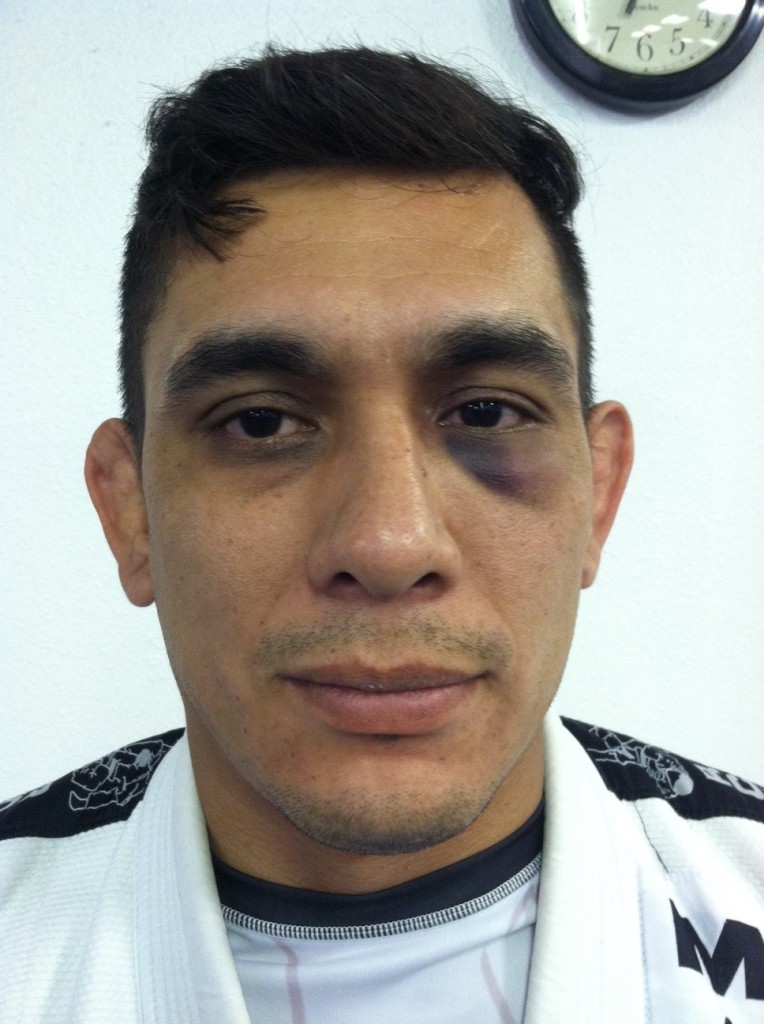DISCLAIMER
Information within this site is for educational purposes only. The U.S. Food & Drug Administration has not evaluated statements about the product efficacy. These products are not intended to diagnose, treat, cure, or prevent any disease. Consult your physician before using for advice.
Periorbital hematoma, or what is known as a black eye or ‘shiner’, is the ecchymosis around the eye commonly due to an injury to the face rather than eye injury. The name is given due to the color of bruising. The so-called black eye is caused by bleeding beneath the skin and around the eye.1
Dr Calvin Inalsingh M.B., Chairman, WBA Medical Advisory Committee discussed injuries in boxing such as hematoma or swelling of the eye from blows:
“…A blow to the face causes the skin to be compressed against the facial bone and the tissue in between is crushed. The blood vessels, which are under the skin, can be ruptured without the skin being damaged. In this case, blood flows into the underlying tissues and causes a swelling or a haematoma. This injury is commonly seen in the skin around the eye. The swelling in this area can be extensive and sometimes completely occludes the vision of the boxer. When the pressure in the haematoma equalizes the pressure in the blood vessels, then the swelling will not get any bigger. The ringside treatment is to apply ice and external pressure on the swelling. This will prevent any further bleeding into the tissues by constricting the blood vessels. The healing process of this injury takes about 5 to 7 days. The underlying blood breaks down in the healing process and it can be seen that the haematoma, which is at first reddish, goes through color changes of blue to black to brown….”2
Dr. Inalsingh states swelling can be reduced in about one week. Usually within two weeks swelling and black eye is yellow-green and eventually fades. Remedies in general on WebMD, are:
“…Besides icy treatment, there’s not much that can be done for a black eye except avoid doing anything that could cause further injury, such as putting pressure on the swollen eye or trying to force it open. If you need a pain reliever, take aspirin or acetaminophen…” (Tylenol).3
Expected duration from swelling of black eye from drugs.com article is generally 7-10 days:
“Most of the swelling and discoloration go away within seven to 10 days after injury. The color of the skin around the eye will change over the course of recovery, typically showing green and yellow tones as the blood ages and is cleared from the tissue.”4
In my Jiu-jitsu class, a student had an accidental colliding with a fellow student. He was unaware of impact, but he developed a hematoma, or black eye and swelling. We read above it usually is 7-10 days to reduce swelling. During class, we had a bottle of St Jude’s Miracle Oil® and immediately took a picture with my iphone at 9:17pm.
Photo 1 9:17pm May 19, 2015
We applied the oil under the eye directly to the swelling. We took a second photo at 9:31:
Photo 2 9:31pm May 19, 2015
I texted student at night and asked if he could take one more pic. He immediately texted me back at 11:00pm another photo.
Photo 3 11:00pm May 19, 2015
The next day during the night class, I stopped by and saw his eye. I took another photo immediately and emailed myself the photo at 6:55pm
Photo 4 6:55pm May 20, 2015
SJMO vs. RICE total time reducing hematoma to normal along with swelling and pain comparison:
1. St Jude’s Miracle Oil® 21 hours, 38 minutes
2. Standard RICE therapy 7-10 days
Student told me he had applied the oil around noon that day and when he saw me a few minutes before the last photo. Normally, according to medical research as referenced above by Dr Calvin Inalsingh M.B., Chairman of WBA Medical Advisory Committee in professional boxing reducing swelling to normal usually takes 7-10 days. What is more evidence of the fast swelling reduced is you can view in last photo student’s black eye is still dark, has not become yellow or light colored yet.
Wounds
Hematoma or in this case a black eye is swelling induced from inflammation. Essential oils in St Jude’s Miracle Oil® referenced from medical journals reduce inflammation. Studies give hope on Myrrh, Frankincense, Lavender, Peppermint, Eucalyptus, Geranium for future research on wound healing. (See article Essential oils in studies for wounds, bleeding)5,6
Myrrh (Commiphora molmol) has been widely used as an anti-inflammatory and wound healing commercial product(1)
In addition to anti-inflammatory effects, Frankincense has been shown to have wound healing, antiulcer, and anti-diarrheal properties.(2)
From PubMed, this paper reports on a literature review of evidence on the influence of essential oils on wound healing and their potential application in clinical practice. It focuses mainly on tea tree, lavender, chamomile, thyme and ocimum oils. (3)
Among the PubMed claims made for lavender oil are that is it antibacterial, antifungal, carminative (smooth muscle relaxing), sedative, antidepressive and effective for burns and insect bites.(4)
This study on PubMed compared the effects of transcutaneous electrical nerve stimulation (TENS), saline solution (SS), povidone-iodine (PI), and lavender oil (Lavandula angustifolia) through expression of growth factors in a rat model of wound healing. Wound closure progressed more rapidly in the TENS and lavender oil groups than in the control and other study groups.(5)
A natural polymeric composite films made of essential oils (EOs) dispersed in sodium alginate (NaAlg) matrix, with remarkable anti-microbial and anti-fungal properties. Namely, elicriso italic, chamomile blue, cinnamon, lavender, tea tree, peppermint, eucalyptus, lemongrass and lemon oils were encapsulated in the films as potential active substances.(6)
In this study the tested geranium oil was efficacious against Gram-negative pathogens responsible for problems with wound treatment. The results suggest that geranium oil may be considered an effective component of therapy in the case of frequent recurrences of infections caused by resistant pathogens.(7)
This complimentary study also discusses the use of myrrh in wound management.(8)
Wintergreen acts as an anti-inflammatory agent (9). inflammatory, and antimicrobial, among others(10), inflammatory and analgesic properties(11), and pain relief assessment(12), inflammatory and analgesic properties(13), anti fungal effects(14). Geranium has shown temporary relief of neuralgia pain (15).
Clary Sage in pain relief on outpatients with primary dysmenorrhea (16).
Frankincense was used for symptomatic knee osteoarthritis (17)
Myrrh oil has anti-inflammatory and analgesic activity (18)
William Vandry
Co-Inventor St Jude’s Miracle Oil® product
References:
1. http://www.medicalnewstoday.com/articles/249231.php
2. http://www.wbanews.com/box-medical-articles/some-common-injuries-in-boxing
3. SOURCES: James B.; Chew C, Bron A. “Trauma,” Lecture Notes on Ophthalmology, Blackwell Publishing, 2003. AmericanAcademy of Ophthalmology
4. http://www.drugs.com/health-guide/black-eye.html
5. https://www.stjudesmiracleoil.com/essential-oils-in-studies-for-wounds-bleeding/
6. Medical references:
1. http://www.ncbi.nlm.nih.gov/pubmed/19995243
2. Rahimi R, Shams-Ardekani MR, Abdollahi M. A review of the efficacy of traditional Iranian medicine for inflammatory bowel disease. World J Gastroenterol. 2010;16:4504–14. http://www.ncbi.nlm.nih.gov/pmc/articles/PMC3924999/
3. J Wound Care. 2007 Jun;16(6):255-7. http://www.ncbi.nlm.nih.gov/pubmed/17722522
4. Phytother Res. 2002 Jun;16(4):301-8. http://www.ncbi.nlm.nih.gov/pubmed/12112282
5. Evid Based Complement Alternat Med. 2013;2013:361832. doi: 10.1155/2013/361832. Epub 2013 Jun 3 http://www.ncbi.nlm.nih.gov/pubmed/23861704
6. Int J Pharm. 2014 Mar 25;463(2):137-45. doi: 10.1016/j.ijpharm.2013.10.046. Epub 2013 Nov 5. http://www.ncbi.nlm.nih.gov/pubmed/24211443
7. 2014 Aug;40(5):1046-51. doi: 10.1016/j.burns.2013.11.002. Epub 2013 Nov 28. http://www.ncbi.nlm.nih.gov/pubmed/24290961
8. use of Myrrh in wound management, J Vasc Nurs. 2010 Sep;28(3):102. doi: 10.1016/j.jvn.2010.06.001. http://www.ncbi.nlm.nih.gov/pubmed/20709267
Methyl salicylate 2-O-β-D-lactoside, a novel salicylic acid analogue, acts as an anti-inflammatory agent on microglia and astrocytes.Lan X, Liu R, Sun L, Zhang T, Du G.J Neuroinflammation. 2011 Aug 11;8:98. doi: 10.1186/1742-2094-8-98.
9. A novel naturally occurring salicylic acid analogue acts as an anti-inflammatory agent by inhibiting nuclear factor-kappaB activity in RAW264.7 macrophages. Zhang T, Sun L, Liu R, Zhang D, Lan X, Huang C, Xin W, Wang C, Zhang D, Du G.Mol Pharm. 2012 Mar 5;9(3):671-7. doi: 10.1021/mp2003779. Epub 2012 Feb 15.
10. Anti-inflammatory activity of methyl salicylate glycosides isolated from Gaultheria yunnanensis (Franch.) Rehder.Zhang D, Liu R, Sun L, Huang C, Wang C, Zhang DM, Zhang TT, Du GH. Molecules. 2011 May 9;16(5):3875-84. doi: 10.3390/molecules16053875
11. Evaluation of the new anti-inflammatory compound ethyl salicylate 2-O-β-d-glucoside and its possible mechanism of action. Xin W, Huang C, Zhang X, Zhang G, Ma X, Sun L, Wang C, Zhang D, Zhang T, Du G.Int Immunopharmacol. 2012 Dec 4;15(2):303-308. doi:10.1016/j.intimp.2012.11.014.
12. Mullally BH, James JA, CoulterWA, Linden GJ. The efficacy of a herbal-based toothpaste on the control of plaque and gingivitis. J Clin Periodontol. 1995;22(9):686–9.
13. Hajhashemi, V., Ghannadi, A., & Sharif, B. (2003). Anti-inflammatory and analgesic properties of the leaf extracts and essential oil of lavandula angustifolia mill. Journal of Ethnopharmacology, 89(1), 67-71.(Lavender)
14. Pain relief assessment by aromatic essential oil massage on outpatients with primary dysmenorrhea: a randomized, double-blind clinical trial. Ou MC, Hsu TF, Lai AC, Lin YT, Lin CC. SourceDepartment of Applied Cosmetology, HungkuangUniversity, Taichung, Taiwan
15. Phytochemical composition of Cymbopogon citratus and Eucalyptus citriodora essential oils and their anti-inflammatory and analgesic properties on Wistar rats. Gbenou JD, Ahounou JF, Akakpo HB, Laleye A, Yayi E, Gbaguidi F, Baba-Moussa L, Darboux R, Dansou P, Moudachirou M, Kotchoni SO. SourceLaboratoire de Pharmacognosie et des Huiles Essentielles, Faculté des Sciences de la Santé, Faculté des Sciences et Techniques, Université d’Abomey Calavi, 01 BP 918, Cotonou, Benin.
16. Antifungal activity of the clove essential oil from aromaticum on Candida, Aspergillus and dermatophyte species Euge´ nia Pinto,1 Luı´s Vale-Silva,1 Carlos Cavaleiro2 and Lı´gia Salgueiro2
17. Curr Med Chem. 2003 May;10(10):813-29.Antibacterial and antifungal properties of essential oils. Kalemba D, Kunicka A.SourceInstitute of General Food Chemistry, Technical University of Lodz, Poland.
18. 20Greenway, f, Frome & Engels, T. (2003). Temporary relief of postherpetic neuralgia pain with topical geranium oil. American J of Medicine, 115, 586-587.
19. Pain relief assessment by aromatic essential oil massage on outpatients with primary dysmenorrhea: a randomized, double-blind clinical trial. Ou MC, Hsu TF, Lai AC, Lin YT, Lin CC. SourceDepartment of Applied Cosmetology, HungkuangUniversity, Taichung, Taiwan. michelle.ouou@gmail.com
20. Rheumatology (Oxford). 2013 Jan 30. Ayurvedic medicine offers a good alternative to glucosamine and celecoxib in the treatment of symptomatic knee osteoarthritis: a randomized, double-blind, controlled equivalence drug trial. Source Center for Rheumatic Diseases, Pune, School of Biomedical Sciences, Symbiosis International University, Pune, BJ Medical College, Pune, Department of Rheumatology, Nizam Institute of Medical Sciences, Hyderabad, Department of Medicine, All India Institute of Medical Sciences, Delhi, Interactive Research School for Health Affairs, Bharati Vidyapeeth Deemed University, Pune, SPARC Institute, Mumbai, Department of Medicine, KEM Hospital, Mumbai and Symbiosis International University, Pune, India
21. Anti-inflammatory and analgesic activity of different extracts of Commiphora myrrha. Source: Jiangsu Key Laboratory for TCM Formulae Research, NanjingUniversity of Chinese Medicine, Nanjing 210046, PR China.




